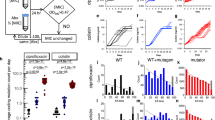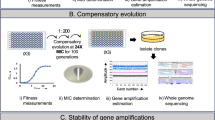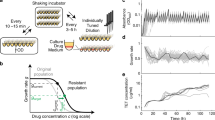Abstract
Antibiotic resistance can evolve through the sequential accumulation of multiple mutations1. To study such gradual evolution, we developed a selection device, the 'morbidostat', that continuously monitors bacterial growth and dynamically regulates drug concentrations, such that the evolving population is constantly challenged2,3,4,5. We analyzed the evolution of resistance in Escherichia coli under selection with single drugs, including chloramphenicol, doxycycline and trimethoprim. Over a period of ∼20 days, resistance levels increased dramatically, with parallel populations showing similar phenotypic trajectories. Whole-genome sequencing of the evolved strains identified mutations both specific to resistance to a particular drug and shared in resistance to multiple drugs. Chloramphenicol and doxycycline resistance evolved smoothly through diverse combinations of mutations in genes involved in translation, transcription and transport3. In contrast, trimethoprim resistance evolved in a stepwise manner1,6, through mutations restricted to the gene encoding the enzyme dihydrofolate reductase (DHFR)7,8. Sequencing of DHFR over the time course of the experiment showed that parallel populations evolved similar mutations and acquired them in a similar order9.
This is a preview of subscription content, access via your institution
Access options
Subscribe to this journal
Receive 12 print issues and online access
$209.00 per year
only $17.42 per issue
Buy this article
- Purchase on Springer Link
- Instant access to full article PDF
Prices may be subject to local taxes which are calculated during checkout




Similar content being viewed by others
Accession codes
References
Weinreich, D.M., Delaney, N.F., Depristo, M.A. & Hartl, D.L. Darwinian evolution can follow only very few mutational paths to fitter proteins. Science 312, 111–114 (2006).
Bryson, V. & Szybalski, W. Microbial selection. Science 116, 45–51 (1952).
Lee, H.H., Molla, M.N., Cantor, C.R. & Collins, J.J. Bacterial charity work leads to population-wide resistance. Nature 467, 82–85 (2010).
Zhang, Q. et al. Acceleration of emergence of bacterial antibiotic resistance in connected microenvironments. Science 333, 1764–1767 (2011).
Lane, P.G., Hutter, A., Oliver, S.G. & Butler, P.R. Selection of microbial mutants tolerant to extreme environmental stress using continuous culture-control design. Biotechnol. Prog. 15, 1115–1124 (1999).
Lozovsky, E.R. et al. Stepwise acquisition of pyrimethamine resistance in the malaria parasite. Proc. Natl. Acad. Sci. USA 106, 12025–12030 (2009).
Matthews, D.A. et al. Dihydrofolate reductase: x-ray structure of the binary complex with methotrexate. Science 197, 452–455 (1977).
Schnell, J.R., Dyson, H.J. & Wright, P.E. Structure, dynamics, and catalytic function of dihydrofolate reductase. Annu. Rev. Biophys. Biomol. Struct. 33, 119–140 (2004).
Couñago, R., Chen, S. & Shamoo, Y. In vivo molecular evolution reveals biophysical origins of organismal fitness. Mol. Cell 22, 441–449 (2006).
Taubes, G. The bacteria fight back. Science 321, 356–361 (2008).
Lipsitch, M., Bergstrom, C.T. & Levin, B.R. The epidemiology of antibiotic resistance in hospitals: paradoxes and prescriptions. Proc. Natl. Acad. Sci. USA 97, 1938–1943 (2000).
Levy, S.B. & Marshall, B. Antibacterial resistance worldwide: causes, challenges and responses. Nat. Med. 10, S122–S129 (2004).
Martinez, J.L. et al. A global view of antibiotic resistance. FEMS Microbiol. Rev. 33, 44–65 (2009).
Davies, J. & Davies, D. Origins and evolution of antibiotic resistance. Microbiol. Mol. Biol. Rev. 74, 417–433 (2010).
Yee, Y.C., Kisslinger, B., Yu, V.L. & Jin, D.J. A mechanism of rifamycin inhibition and resistance in Pseudomonas aeruginosa. J. Antimicrob. Chemother. 38, 133–137 (1996).
Ruiz, J. Mechanisms of resistance to quinolones: target alterations, decreased accumulation and DNA gyrase protection. J. Antimicrob. Chemother. 51, 1109–1117 (2003).
Chopra, I. & Roberts, M. Tetracycline antibiotics: mode of action, applications, molecular biology, and epidemiology of bacterial resistance. Microbiol. Mol. Biol. Rev. 65, 232–260 (2001).
Huovinen, P. Trimethoprim resistance. Antimicrob. Agents Chemother. 31, 1451–1456 (1987).
Girgis, H.S., Hottes, A.K. & Tavazoie, S. Genetic architecture of intrinsic antibiotic susceptibility. PLoS ONE 4, e5629 (2009).
Albert, T.J. et al. Mutation discovery in bacterial genomes: metronidazole resistance in Helicobacter pylori. Nat. Methods 2, 951–953 (2005).
Friedman, L., Alder, J.D. & Silverman, J.A. Genetic changes that correlate with reduced susceptibility to daptomycin in Staphylococcus aureus. Antimicrob. Agents Chemother. 50, 2137–2145 (2006).
Barrick, J.E. et al. Genome evolution and adaptation in a long-term experiment with Escherichia coli. Nature 461, 1243–1247 (2009).
Yeh, P.J., Hegreness, M.J., Aiden, A.P. & Kishony, R. Drug interactions and the evolution of antibiotic resistance. Nat. Rev. Microbiol. 7, 460–466 (2009).
Michel, J.B., Yeh, P.J., Chait, R., Moellering, R.C. Jr. & Kishony, R. Drug interactions modulate the potential for evolution of resistance. Proc. Natl. Acad. Sci. USA 105, 14918–14923 (2008).
Demerec, M. Production of Staphylococcus strains resistant to various concentrations of penicillin. Proc. Natl. Acad. Sci. USA 31, 16–24 (1945).
Drlica, K. The mutant selection window and antimicrobial resistance. J. Antimicrob. Chemother. 52, 11–17 (2003).
Bull, A.T. The renaissance of continuous culture in the post-genomics age. J. Ind. Microbiol. Biotechnol. 37, 993–1021 (2010).
de Crécy, E. et al. Development of a novel continuous culture device for experimental evolution of bacterial populations. Appl. Microbiol. Biotechnol. 77, 489–496 (2007).
Paalme, T., Elken, R., Kahru, A., Vanatalu, K. & Vilu, R. The growth rate control in Escherichia coli at near to maximum growth rates: the A-stat approach. Antonie van Leeuwenhoek 71, 217–230 (1997).
Yeh, P., Tschumi, A.I. & Kishony, R. Functional classification of drugs by properties of their pairwise interactions. Nat. Genet. 38, 489–494 (2006).
Arjan, J.A. et al. Diminishing returns from mutation supply rate in asexual populations. Science 283, 404–406 (1999).
Okusu, H., Ma, D. & Nikaido, H. AcrAB efflux pump plays a major role in the antibiotic resistance phenotype of Escherichia coli multiple-antibiotic-resistance (Mar) mutants. J. Bacteriol. 178, 306–308 (1996).
Asako, H., Nakajima, H., Kobayashi, K., Kobayashi, M. & Aono, R. Organic solvent tolerance and antibiotic resistance increased by overexpression of marA in Escherichia coli. Appl. Environ. Microbiol. 63, 1428–1433 (1997).
Mankin, A.S., Zyrianova, I.M., Kagramanova, V.K. & Garrett, R.A. Introducing mutations into the single-copy chromosomal 23S rRNA gene of the archaeon Halobacterium halobium by using an rRNA operon-based transformation system. Proc. Natl. Acad. Sci. USA 89, 6535–6539 (1992).
Gerrits, M.M., Berning, M., Van Vliet, A.H., Kuipers, E.J. & Kusters, J.G. Effects of 16S rRNA gene mutations on tetracycline resistance in Helicobacter pylori. Antimicrob. Agents Chemother. 47, 2984–2986 (2003).
Ross, J.I., Eady, E.A., Cove, J.H. & Cunliffe, W.J. 16S rRNA mutation associated with tetracycline resistance in a gram-positive bacterium. Antimicrob. Agents Chemother. 42, 1702–1705 (1998).
Ettayebi, M., Prasad, S.M. & Morgan, E.A. Chloramphenicol-erythromycin resistance mutations in a 23S rRNA gene of Escherichia coli. J. Bacteriol. 162, 551–557 (1985).
Flensburg, J. & Skold, O. Massive overproduction of dihydrofolate reductase in bacteria as a response to the use of trimethoprim. Eur. J. Biochem. 162, 473–476 (1987).
Ohmae, E., Sasaki, Y. & Gekko, K. Effects of five-tryptophan mutations on structure, stability and function of Escherichia coli dihydrofolate reductase. J. Biochem. 130, 439–447 (2001).
Smith, D.R. & Calvo, J.M. Nucleotide sequence of dihydrofolate reductase genes from trimethoprim-resistant mutants of Escherichia coli. Evidence that dihydrofolate reductase interacts with another essential gene product. Mol. Gen. Genet. 187, 72–78 (1982).
Watson, M., Liu, J.W. & Ollis, D. Directed evolution of trimethoprim resistance in Escherichia coli. FEBS J. 274, 2661–2671 (2007).
Lunzer, M., Miller, S.P., Felsheim, R. & Dean, A.M. The biochemical architecture of an ancient adaptive landscape. Science 310, 499–501 (2005).
de Visser, J.A. & Rozen, D.E. Clonal interference and the periodic selection of new beneficial mutations in Escherichia coli. Genetics 172, 2093–2100 (2006).
Wichman, H.A., Badgett, M.R., Scott, L.A., Boulianne, C.M. & Bull, J.J. Different trajectories of parallel evolution during viral adaptation. Science 285, 422–424 (1999).
Crandall, K.A., Kelsey, C.R., Imamichi, H., Lane, H.C. & Salzman, N.P. Parallel evolution of drug resistance in HIV: failure of nonsynonymous/synonymous substitution rate ratio to detect selection. Mol. Biol. Evol. 16, 372–382 (1999).
Li, H. et al. The Sequence Alignment/Map format and SAMtools. Bioinformatics 25, 2078–2079 (2009).
Reva, B., Antipin, Y. & Sander, C. Determinants of protein function revealed by combinatorial entropy optimization. Genome Biol. 8, R232 (2007).
Bollenbach, T., Quan, S., Chait, R. & Kishony, R. Nonoptimal microbial response to antibiotics underlies suppressive drug interactions. Cell 139, 707–718 (2009).
Acknowledgements
The authors thank M. Baym, S. Bershtein, T. Bollenbach, M. Ernebjerg, Y. Gerardin, J. Horn, A. Kocabas, C. Kocabas, D. Landgraf, R. Milo, B. Okumus, A. Palmer, J.M. Pedraza, M. Shuman, I. Wapinski, R. Ward, P. Yeh and all members of the Kishony laboratory for technical help and discussions. This work was supported in part by grants from the US National Institutes of Health (GM081617 to R.K. and GM079536 to D.L.H.) and The New England Regional Center of Excellence for Biodefense and Emerging Infectious Diseases (AI057159 to R.K.). J.-B.M. is supported by a Foundational Questions in Evolutionary Biology Fellowship.
Author information
Authors and Affiliations
Contributions
E.T., A.V., R.C., D.L.H. and R.K. designed the project. E.T. and A.V. performed the experiments and E.T., A.V., J.-B.M. and R.K. analyzed the data. All authors contributed to preparing the manuscript.
Corresponding author
Ethics declarations
Competing interests
The authors declare no competing financial interests.
Supplementary information
Supplementary Text and Figures
Supplementary Figures 1–4, Supplementary Tables 1–3 and Supplementary Note. (PDF 2730 kb)
Rights and permissions
About this article
Cite this article
Toprak, E., Veres, A., Michel, JB. et al. Evolutionary paths to antibiotic resistance under dynamically sustained drug selection. Nat Genet 44, 101–105 (2012). https://doi.org/10.1038/ng.1034
Received:
Accepted:
Published:
Issue Date:
DOI: https://doi.org/10.1038/ng.1034
This article is cited by
-
Analytical methods for assessing antimicrobial activity of nanomaterials in complex media: advances, challenges, and perspectives
Journal of Nanobiotechnology (2023)
-
Intrahost evolution of the gut microbiota
Nature Reviews Microbiology (2023)
-
Embracing Complexity: Yeast Evolution Experiments Featuring Standing Genetic Variation
Journal of Molecular Evolution (2023)
-
Gene flow and introgression are pervasive forces shaping the evolution of bacterial species
Genome Biology (2022)
-
Decreased thermal niche breadth as a trade-off of antibiotic resistance
The ISME Journal (2022)



